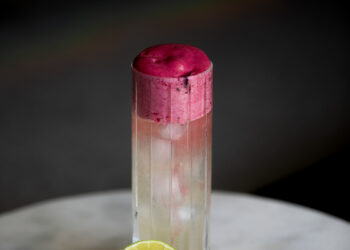To make a Painkiller cocktail, you will need the following ingredients:
- 50ml dark rum
- 100ml pineapple juice
- 25ml orange juice
- 25ml coconut cream
- 1 teaspoon grated nutmeg
- 1 slice pineapple and a cherry, for garnish (optional)
To prepare the cocktail:
- Fill a shaker with ice.
- Add the dark rum, pineapple juice, orange juice, and coconut cream to the shaker.
- Shake the mixture well to combine the ingredients and chill them.
- Strain the mixture into a highball glass filled with ice.
- Sprinkle the grated nutmeg over the top of the drink.
- Garnish with a slice of pineapple and a cherry, if desired.
Note: You can adjust the proportions of the ingredients to suit your taste. Some people prefer a stronger rum flavour and add an extra splash of rum, while others like a sweeter cocktail and add a little more coconut cream. Experiment to find the perfect balance for you.
History of Painkiller
The Painkiller cocktail is a tropical drink that originated at the Soggy Dollar Bar on the island of Jost Van Dyke in the British Virgin Islands. The bar was named for the fact that customers would often arrive by boat and would have to pay for their drinks with wet, soggy dollar bills.
The Painkiller cocktail was created by the bar’s owner, Vincent “Pelican” Van Dyke, in the 1970s. It quickly became a popular drink at the Soggy Dollar Bar and has since spread to other bars and restaurants around the world.
The Painkiller cocktail is made with dark rum, pineapple juice, orange juice, and coconut cream, which gives it a rich, tropical flavour. It is often garnished with grated nutmeg and a slice of pineapple or a cherry. The drink is usually served in a highball glass over ice and is a popular choice for anyone who enjoys a fruity, tropical cocktail.
Variations of Painkiller
A painkiller cocktail is a mixed drink that is typically made with rum and pineapple juice, and sometimes includes other ingredients such as orange juice, coconut cream, and grenadine. Here are a few variations on the classic recipe:
- Guava Painkiller: This version includes white rum, guava juice, orange juice, and coconut cream. It is typically served over ice and garnished with a slice of guava and a cherry.
- Pomegranate Painkiller: This variation combines white rum, pineapple juice, coconut cream, and grenadine for a creamy, tropical drink. It can be served over ice or blended into a frozen cocktail.
- Mango Painkiller: This variation includes white rum, pineapple juice, mango juice, and coconut cream for a tropical, fruity twist on the classic recipe.
- Spiced Painkiller: This variation includes white rum, pineapple juice, orange juice, and coconut cream, but also includes a dash of spices such as cinnamon, nutmeg, and allspice for a warm, spicy kick.
It’s important to note that alcohol should be consumed in moderation and not as a means of relieving pain. If you are experiencing pain, it is important to speak with a healthcare professional for proper diagnosis and treatment.
Best Dark Rum for Painkiller
The best dark rum for a painkiller cocktail will depend on your personal preference. Some options you may want to consider include:
- Mount Gay Eclipse: This smooth, well-balanced rum is made in Barbados and has flavors of vanilla, caramel, and spice.
- Ron del Barrilito: This Puerto Rican rum is aged for up to 30 years and has flavors of oak, dried fruit, and spices.
- Appleton Estate Extra 12: This Jamaican rum is aged for a minimum of 12 years and has flavors of oak, vanilla, and tropical fruit.
- Plantation XO 20th Anniversary: This rum is made in Barbados and aged in oak barrels before being finished in Cognac casks. It has flavors of toffee, vanilla, and tropical fruit.
- Ron Zacapa Centenario Sistema Solera 23: This Guatemalan rum is aged using the solera method and has flavors of raisins, nuts, and spices.
Ultimately, the best dark rum for a painkiller cocktail will be a matter of personal preference. You may want to try a few different options and see which one you prefer. It’s important to note that alcohol should be consumed in moderation and not as a means of relieving pain. If you are experiencing pain, it is important to speak with a healthcare professional for proper diagnosis and treatment.










